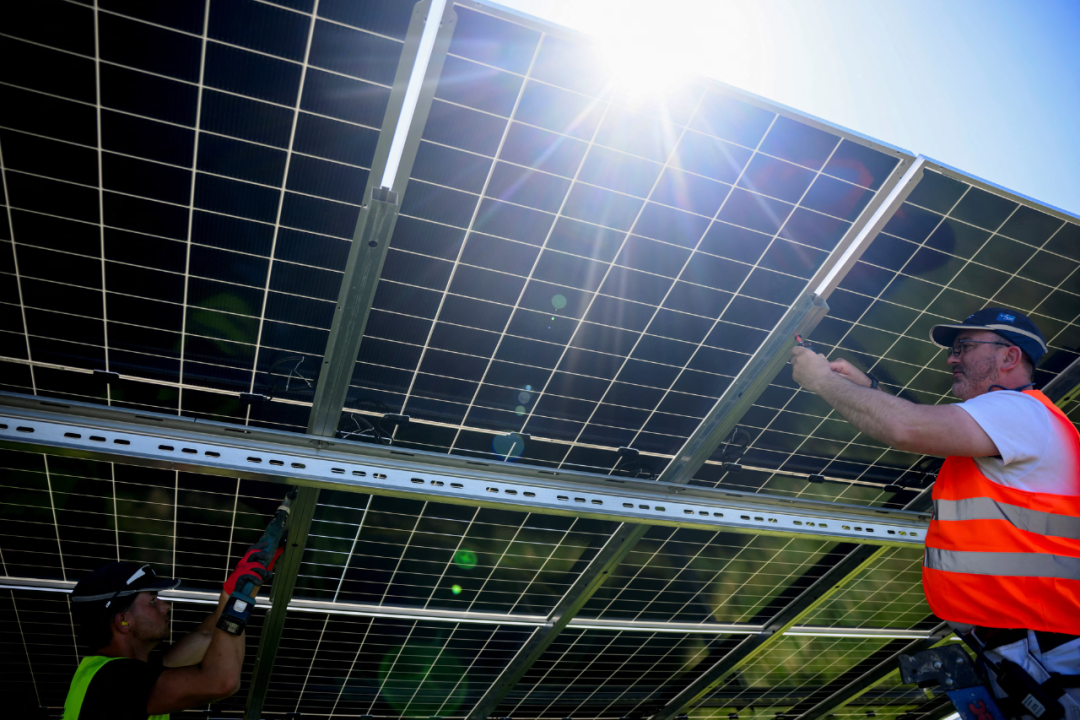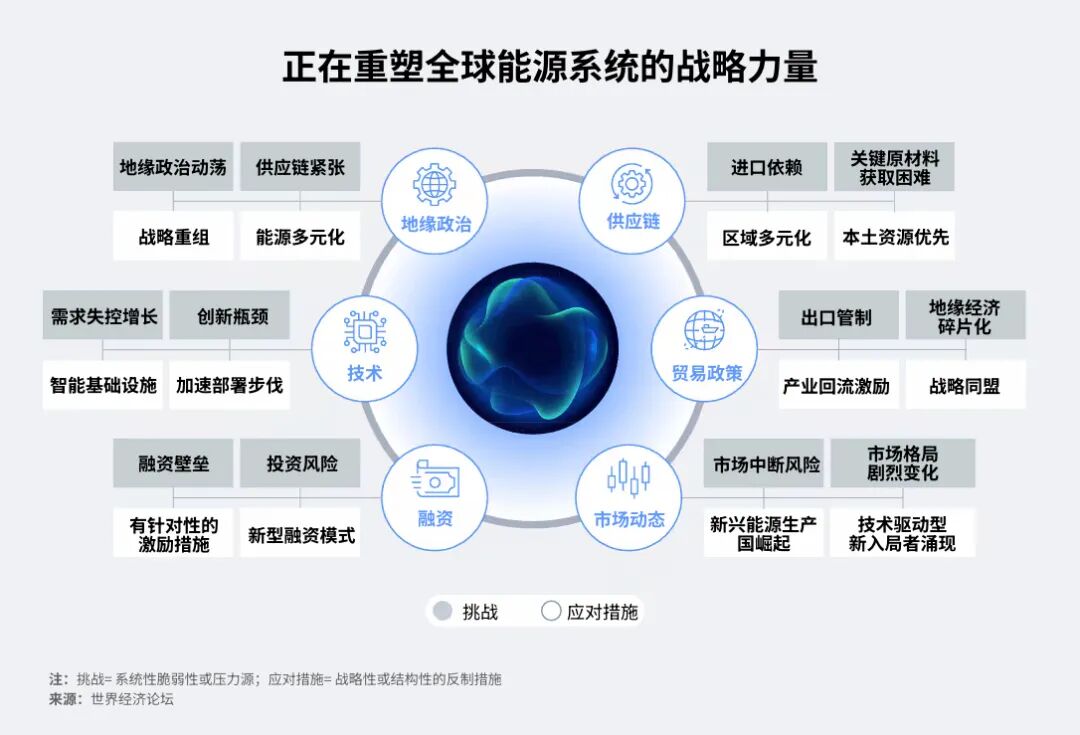

The World Economic Forum's report, "Enabling an Effective Energy Transition 2025," outlines six structural shifts shaping the energy market.
Image source: Reuters/Jana Rodenbusch
Maksim Soshkin
World Economic Forum Research and Analysis Expert
The focus of energy policy is shifting from a singular emphasis on sustainability to a comprehensive consideration of the triple goal: "security, affordability, and sustainability."
As geopolitical and economic risks rise, countries are reshaping their respective energy strategies.
The World Economic Forum's report, "Enabling an Effective Energy Transition 2025," outlines six structural shifts currently shaping the energy transition.
The World Economic Forum's report, "Driving an Effective Energy Transition by 2025," reveals that six major structural shifts are reshaping the energy market amid growing global uncertainty. For instance, oil prices have experienced sharp volatility due to conflicts in the Middle East—yet supply has remained unaffected. These developments are already influencing investment decisions and redefining the future role of key energy sources.
The report outlines these changes as follows:

The pivotal shift shaping the evolving energy landscape.
Image source: World Economic Forum
The Role of Liquefied Natural Gas in the Energy Transition
Liquefied Natural Gas (LNG) is natural gas cooled into a liquid state, making it easier to transport and store—and it’s often referred to as the “transition fuel” of the energy transition. This is because LNG can provide a stable supply of electricity to the grid, addressing the intermittent nature of renewable energy sources, while also producing lower carbon emissions compared to coal and oil.
However, as people place greater emphasis on the security of the energy triangle, liquefied natural gas is undergoing a redefinition of its role in the global energy landscape. While critics question whether we should shift toward other fossil fuels, an alternative viewpoint is gaining traction: LNG isn’t just a transitional fuel—it’s actually a "final-fuel" option.
Technological innovations like carbon capture are expected to further reduce emissions from liquefied natural gas. Meanwhile, as geopolitical uncertainties intensify, countries are increasingly looking to diversify their energy supplies, prompting many regions to introduce robust policy support for LNG.
According to data from the International Energy Agency, liquefied natural gas (LNG) demand is set to surge in 2024 and 2025, particularly in Asia and Europe, as countries seek alternatives to Russian pipeline gas. While global supply growth is expected to slow to 2% in 2024, new projects are poised to boost LNG supply growth, helping it rebound to nearly 6% in 2025.
Nuclear energy is steadily making a comeback.
Currently, nuclear power accounts for nearly 10% of the world's electricity supply. However, since it is a crucial energy source capable of providing reliable baseload power, momentum for its development is steadily growing—with small modular reactors (SMRs) now at the forefront of this transformative shift.
Small modular reactors generate about one-third the electricity of traditional large-scale reactors, yet they are safer, less expensive, faster to build, and better suited to diverse locations and energy needs. Like all nuclear power plants, small modular reactors produce no greenhouse gas emissions. Moreover, unlike conventional nuclear plants, these smaller reactors can be easily shut down and restarted, offering greater operational flexibility.
This flexibility makes small modular reactors an ideal choice for phasing out coal while also complementing liquefied natural gas to deliver stable, dispatchable energy. Global investment in nuclear power is on the rise, particularly in China, where installed nuclear capacity is projected to surpass that of the U.S. and Europe by 2030.
Energy efficiency is the "first fuel" of the energy transition.
Energy efficiency, alongside electrification, behavioral changes, and digitalization, is shaping global energy intensity—the amount of energy required to produce a unit of GDP. It stands as one of the most cost-effective ways to enhance energy security, cut emissions, and lower costs, often referred to as the "first fuel" in the clean energy transition.
A study by the World Economic Forum and PwC found that improving energy efficiency could reduce global energy consumption by 31%, leading to annual savings of over $2 trillion in energy costs—while keeping economic output unchanged.
Smart grids, AI-driven analytics, and demand-response initiatives are enhancing energy efficiency. Behavioral incentives are encouraging people to adopt more mindful consumption habits, thereby supporting the development of a more resilient, low-carbon energy system.
Energy storage solutions are the cornerstone of energy integration.
As intermittent renewable energy sources continue to be integrated, energy storage emerges as another critical component for grid stability and balancing supply with demand.
By 2030, global power generation capacity is expected to surpass 2 TWh, with an average annual installation growth rate of 21%. China is projected to lead with a 43% share, followed by the United States (14%), Europe, and India.
Battery systems, hydrogen energy, and pumped-storage hydropower are all exemplary technologies that enhance the flexibility of low-carbon energy systems.
Global clean energy technology spending hits record high
Clean energy investments are now surpassing those in fossil fuels, with global energy transition investments growing by 11% in 2024—reaching a record-breaking $2.1 trillion. The power sector is leading this transformation by scaling up solar, wind, and smart grid technologies.
As decarbonization efforts expand into harder-to-abate sectors, emerging technologies like carbon capture and storage are also beginning to gain attention.
However, the success of clean technologies depends on robust supply chains and reliable access to critical resources—making supply-chain resilience increasingly vital.
The Impact of Artificial Intelligence on Energy Systems
Artificial intelligence is reshaping energy systems—while it brings significant efficiency gains, its own massive energy and resource consumption continues to rise.
By 2030, data centers powering generative AI tools could drive a 10% increase in global electricity demand. While global energy consumption is influenced by multiple factors—such as air conditioning use and industrial consumption—the concentration of 11,000 data centers in key regional hubs may have a significant impact on local power markets.
The growth of artificial intelligence is also impacting resource demands—by 2030, large and hyperscale data centers are projected to account for nearly 70% of the copper demand in the construction sector.
On the other hand, intelligent predictions powered by artificial intelligence technology are expected to reduce global greenhouse gas emissions by 5–10% by 2030. A key challenge in the development of AI is ensuring that its benefits outweigh its potential impacts, so that digitalization truly becomes a "lever" for the energy transition—rather than a "burden."
The energy landscape is becoming increasingly complex, localized, and digital. The "2025 Report on Promoting an Effective Energy Transition" highlights that successfully navigating this transformation requires the development of a comprehensive strategy—one that aligns energy policies, financing, and technology—to accelerate the shift toward a secure, low-carbon future.

The above content solely represents the author's personal views.This article is translated from the World Economic Forum's Agenda blog; the Chinese version is for reference purposes only.Feel free to share this in your WeChat Moments; please leave a comment at the end of the article or on our official account if you’d like to republish.
Editor: Wang Can
The World Economic Forum is an independent and neutral platform dedicated to bringing together diverse perspectives to discuss critical global, regional, and industry-specific issues.
Follow us on Weibo, WeChat Video Accounts, Douyin, and Xiaohongshu!
"World Economic Forum"


